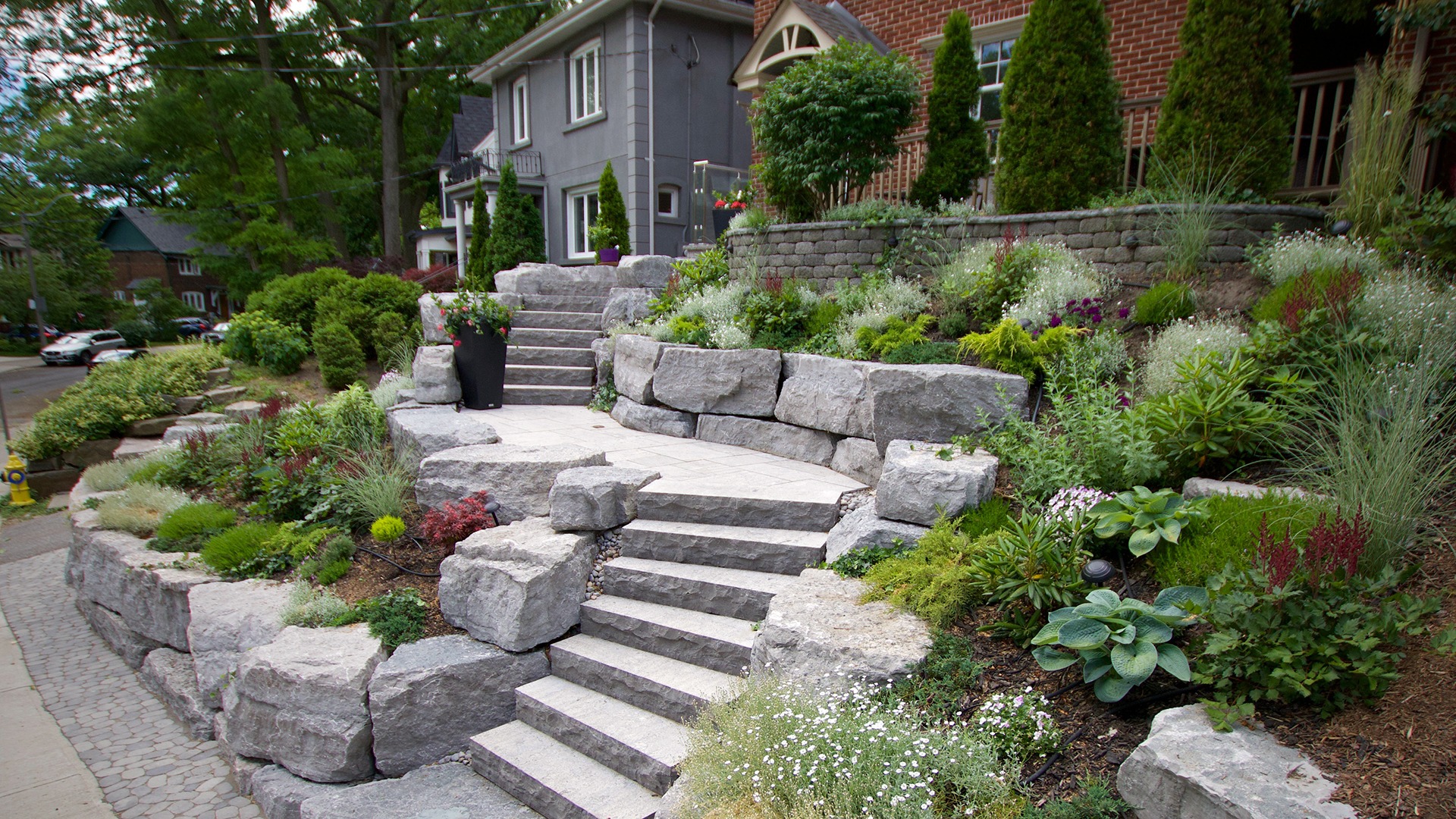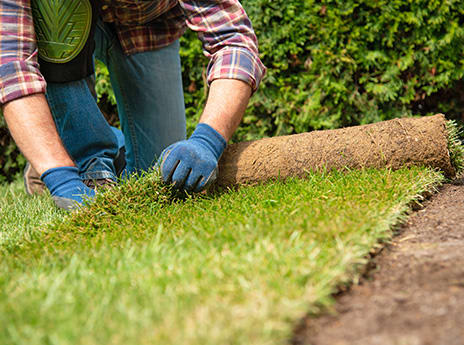Understanding the Comprehensive Extent of Works in Specialist Landscape Design Services
The extensive range of expert landscaping services includes a selection of fundamental elements - landscaping services. It includes landscape style concepts, plant choice, and hardscaping features. Furthermore, it addresses watering systems and maintenance approaches. Each aspect plays a vital role in producing useful and aesthetically pleasing outdoor spaces. Comprehending exactly how these components collaborate can expose much concerning the art and scientific research of landscape design. The journey right into this elaborate area is simply starting.
Landscape Design Principles
Reliable landscape style principles are essential for producing unified exterior spaces that boost both aesthetic allure and functionality (Learn More). These principles assist the arrangement of elements within the landscape, making sure a natural visual experience. Trick parts consist of balance, which distributes aesthetic weight evenly; proportion, which relates the size of different components per other and the room; and unity, which develops a feeling of integrity with consistent themes and materials

Plant Selection and Installation
In the domain of professional landscape design, plant selection and setup play a crucial duty in attaining a growing yard. Highlighting indigenous plant advantages, seasonal considerations, and the particular soil and sunshine requirements of each species guarantees a sustainable and cosmetically pleasing landscape. Cautious planning in these locations not only improves biodiversity yet additionally advertises long-lasting environmental health.
Native Plant Benefits
Why should home owners consider native plants for their landscaping tasks? Native plants provide many benefits that enhance both appearances and ecological sustainability. They are well-adapted to neighborhood climates, calling for less water and maintenance compared to non-native species. This resilience lowers the requirement for chemical plant foods and pesticides, promoting a healthier ecosystem. Furthermore, native plants offer habitat and food for local wildlife, consisting of pollinators, which can enhance biodiversity in residential areas. Their familiarity with regional dirt and climate condition likewise leads to better development rates and longevity. By choosing indigenous plants, home owners not just develop aesthetically enticing landscapes but likewise add to environmental preservation, making a favorable effect on their regional environment. Consequently, indigenous plants represent a clever choice for landscape design jobs.
Seasonal Plant Considerations
Property owners who have actually welcomed native plants in their landscaping can better enhance their outside rooms by taking into consideration seasonal plant selections. By integrating plants that thrive in certain seasons, they can produce dynamic and aesthetically attractive landscapes throughout the year. Springtime may introduce vibrant blossoms like daffodils and tulips, while summer season can display lush foliage and colorful perennials. Autumn presents a scheme of warm tones with asters and goldenrods, while winter months can be accentuated with evergreens and decorative lawns for structure. Professional landscaping companies frequently advise picking plants that not only complement existing native species yet additionally offer year-round rate of interest and assistance local wildlife. This thoughtful technique to seasonal plant choice guarantees a continuously developing and lasting garden environment.
Soil and Sunlight Requirements
Successful landscape design depends upon comprehending the certain dirt and sunlight requirements of plants. Various species prosper under varying problems, requiring a mindful evaluation of both factors throughout the selection process. Soil types, such as sandy, clay, or fertile, influence drainage, nutrient availability, and origin development. Additionally, pH levels can influence plant health, necessitating dirt screening to determine viability. Sunshine needs vary substantially; some plants flourish in complete sun, while others favor full or partial color. A professional landscaper considers these aspects to assure peak development and aesthetic allure. By straightening plant choices with the environment's specific features, landscapes can achieve sustainability, durability, and visual consistency, inevitably bring about successful plant establishment and lasting upkeep.
Hardscaping Features and Construction

While landscaping usually stimulates photos of rich greenery and dynamic flowers, hardscaping features play a vital duty in specifying exterior rooms. These components, which include patio areas, sidewalks, preserving wall surfaces, and ornamental stonework, offer structure and performance to gardens and yards. Hardscaping makes use of products such as concrete, timber, rock, and block, permitting diverse styles that enhance the natural landscape.
The construction of hardscaping features needs careful planning and implementation to ensure durability and visual appeal. Specialists examine site conditions, drainage, and spatial relationships to develop natural outdoor atmospheres. Correct setup techniques are critical, as they stop issues like erosion and moving with time.
Incorporating hardscaping not only boosts the visual passion of a building however also assists in outside activities, making it a basic element of extensive landscaping services. Inevitably, thoughtful hardscaping adds to both the functionality and beauty of exterior spaces.
Watering Solutions and Water Management
Effective watering systems and water monitoring are important components of expert landscaping, as they ensure that plants obtain the necessary hydration for excellent development. These systems can differ from easy drip watering arrangements to innovative automated lawn sprinkler, created to fulfill the specific demands of diverse landscapes. Proper water administration not only optimizes water usage, minimizing waste, however additionally improves plant health and minimizes condition dangers.
Landscape design experts evaluate different aspects, consisting of dirt type, plant species, and regional climate, to establish tailored irrigation solutions. Additionally, integrating rain harvesting strategies can even more boost sustainability and effectiveness. Normal upkeep of watering systems is important Click This Link to keep functionality and protect against leakages, which can cause water loss and boosted prices (Learn More). Ultimately, a properly designed irrigation system plays a crucial role in maintaining the aesthetic appeal of outside areas while promoting ecological stewardship within specialist landscaping techniques
Grass Treatment and Maintenance Approaches
Yard care and maintenance techniques are fundamental for accomplishing a lush, healthy lawn that improves the overall landscape. These methods encompass numerous techniques targeted at advertising ideal development and visual charm. Regular mowing is necessary, as it urges thick, also growth while preventing weeds from developing. Additionally, appropriate fertilizing supplies necessary nutrients, with applications customized to the particular turf type and dirt problems.
Watering practices should concentrate on deep, infrequent watering to encourage root advancement, while oygenation improves dirt framework and promotes nutrition absorption. Bug and illness management is likewise crucial; identifying concerns early permits efficient therapies that decrease damage.
Finally, overseeding can renew damaged or thin yards, boosting thickness and color. By executing these targeted lawn treatment strategies, landscaping specialists can guarantee that lawns stay healthy and vibrant throughout the periods, significantly adding to the general elegance of the residential or commercial property
Seasonal Landscape Treatment and Maintenance
As the seasons modification, correct landscape treatment comes to be important for maintaining the wellness and charm of outside areas. Each season presents one-of-a-kind difficulties and needs. In spring, landscape specialists focus on trimming, growing, and fertilizing to encourage growth. Summer demands routine watering, weed control, and pest management to secure freshly established plants.

Throughout the year, seasonal landscape upkeep guarantees that outdoor locations remain healthy and aesthetically enticing. Professional services can give tailored upkeep strategies that adapt to the certain demands of each period, allowing homeowner to delight in lively landscapes year-round. On the whole, seasonal care is a vital facet of specialist landscape design that advertises longevity and visual value.

Sustainable Landscaping Practices
An expanding variety of homeowner are embracing sustainable landscaping methods to create environmentally friendly outside rooms. These practices concentrate on saving resources, improving biodiversity, and decreasing ecological impact. Native plants are usually chosen for their low water needs and compatibility with local ecological communities, decreasing the requirement for chemical plant foods and chemicals. Rain gardens and permeable paving are utilized to manage stormwater drainage, advertising groundwater recharge and decreasing disintegration.
Moreover, sustainable landscaping includes natural gardening strategies that prioritize soil health and advertise natural pest control. Efficient watering systems, such as drip irrigation and rainwater harvesting, aid enhance water usage. Additionally, landscape developers increasingly advocate for the use of recycled products, such as reclaimed wood and stones, to minimize waste. By embracing these lasting methods, residential property owners not only add to eco-friendly conservation yet likewise develop aesthetically pleasing atmospheres that can love marginal upkeep.
Often Asked Concerns
For how long Does a Landscape Design Job Commonly Require To Total?
Normally, a landscape design project can take anywhere from a couple of days to a number of weeks to complete, depending upon the task's size, design, and complexity requirements. Factors such as weather condition and source availability also influence timelines.
What Factors Influence the Price of Landscape Design Services?
Numerous variables influence landscape design solution costs, consisting of project dimension, layout complexity, material quality, labor expenses, geographic location, and seasonal need. Each element contributes distinctively to the overall economic needs of a landscaping task.
Are Landscape Design Solutions Available Year-Round?
Landscaping services are usually available year-round, although schedule may differ based on region, seasonal weather, and specific service offerings. Some services may be restricted during severe weather condition or off-peak seasons.
Do Landscaping Business Deal Service Warranties on Their Work?
Several landscaping companies do provide guarantees on their work, which can vary in size and protection. Customers are urged to ask regarding specific terms, guaranteeing they understand what is ensured and any type of problems that apply.
Can I Style My Landscape Without Expert Aid?
Yes, people can create their landscapes without specialist aid. They might lack proficiency in plant option, design, and environmental factors to consider, possibly leading to much less reliable designs that might need pricey changes later on.
In the domain name of specialist landscaping, plant option and installation play an essential role in attaining a growing yard. Home owners who have embraced native plants in their landscape design can better enhance their outdoor areas by thinking about seasonal plant choices. Successful landscape design pivots on comprehending the details soil and sunshine requirements of plants. Effective watering systems and water management are crucial components of expert landscaping, as they assure that plants get the needed hydration for perfect development. Landscape design specialists evaluate different elements, including dirt type, plant types, and neighborhood climate, to develop tailored irrigation remedies.